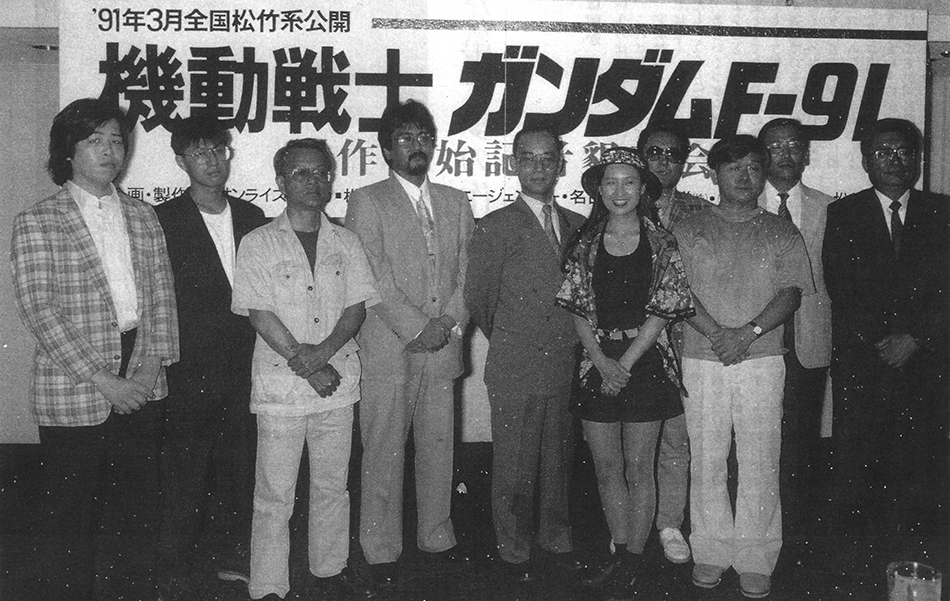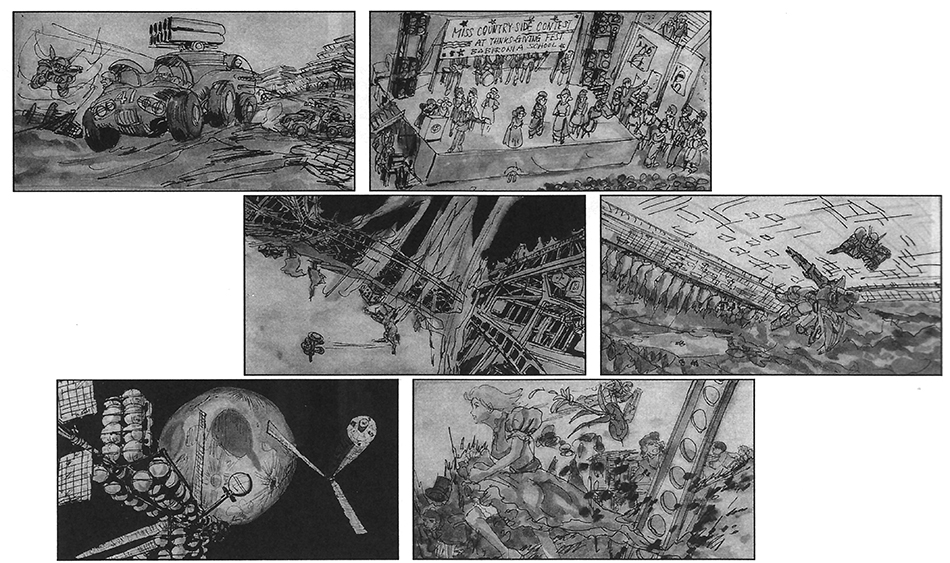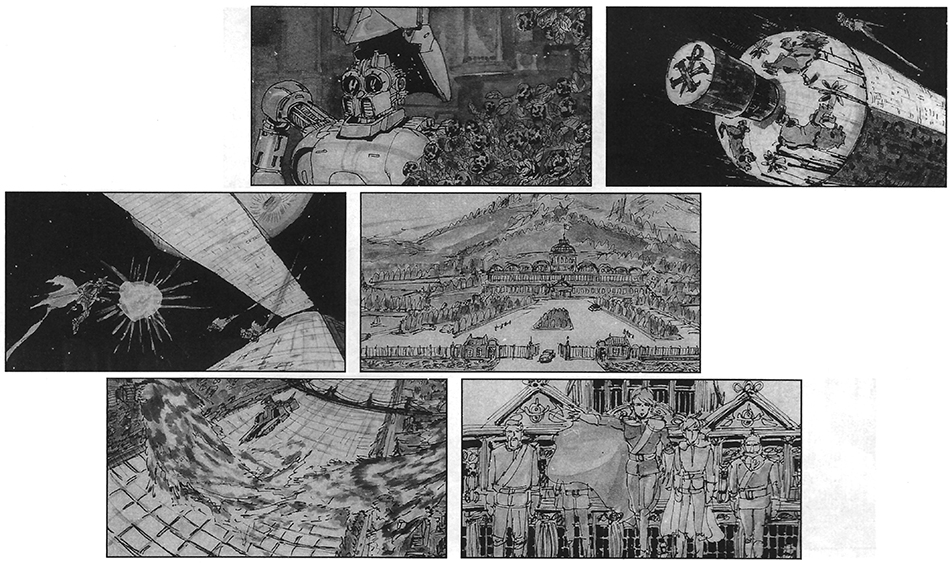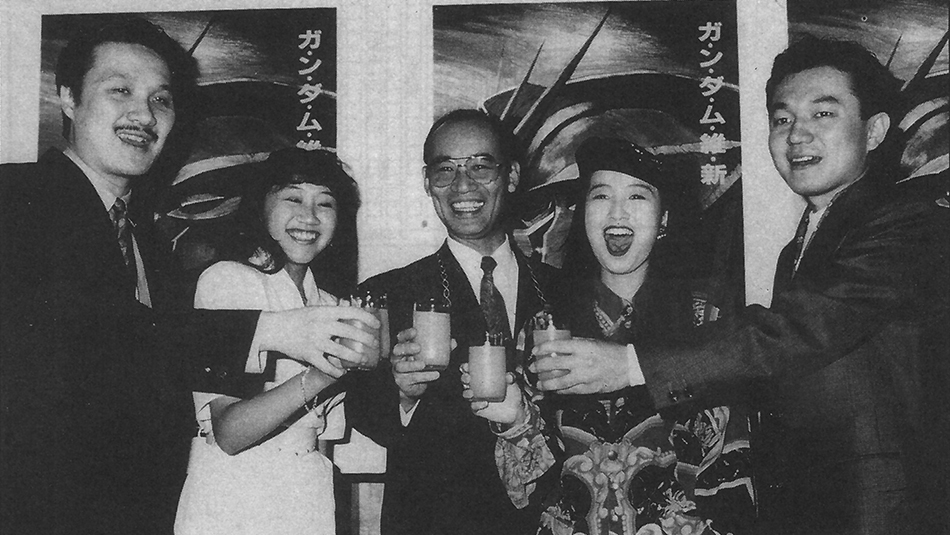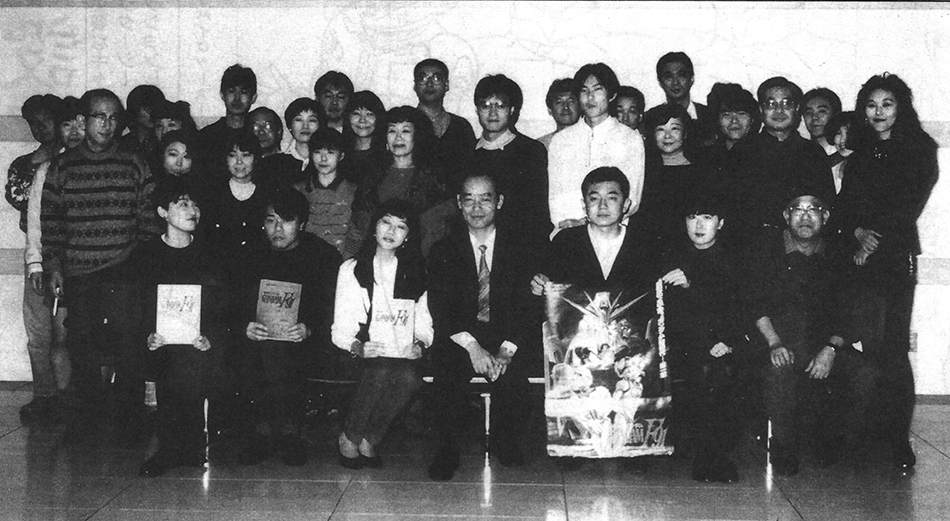YOSHIYUKI TOMINO’S UNIVERSAL CENTURY
Gundam F91, the latest in the series, has taken more than two years to plan and produce, requiring the same high quality as Char’s Counterattack. Below, I’ve summarized a discussion with Tomino, who was in charge of the production as the original author and general director. Throughout the article, he discusses the progress and reveals the development and planning process leading up to its completion. I hope that by revealing some of these details, fans will understand his intended appeal of the work and provide some more insight into why it came off as slightly disjointed.
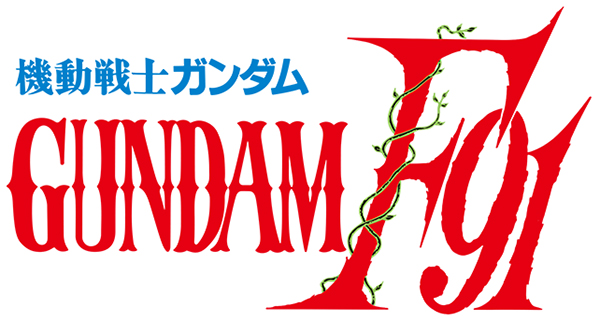
THIS IS A NEW FIRST STEP
WHAT IS F91?
When asked what F91 is, Tomino says that the F in F91 means “form,” but this is not naming based on the notion of a completed machine, much like the RX series, but just a number with a production date. The true intention was to ensure that there were more Gundams to come.
When setting out to establish a theme for the work, if he followed the patterns like “Newtype,” “enemy ally theory,” or the “bigger enemy.” then it would lead to failure. So, he elected a familiar theme: family problems. On the frontier of space, what happens to the fundamental human “family?” How does a family interact with one another? He rejected the idea of a drama with a protagonist who is a “pilot aiming to become a Newtype” in order to expand his abilities.
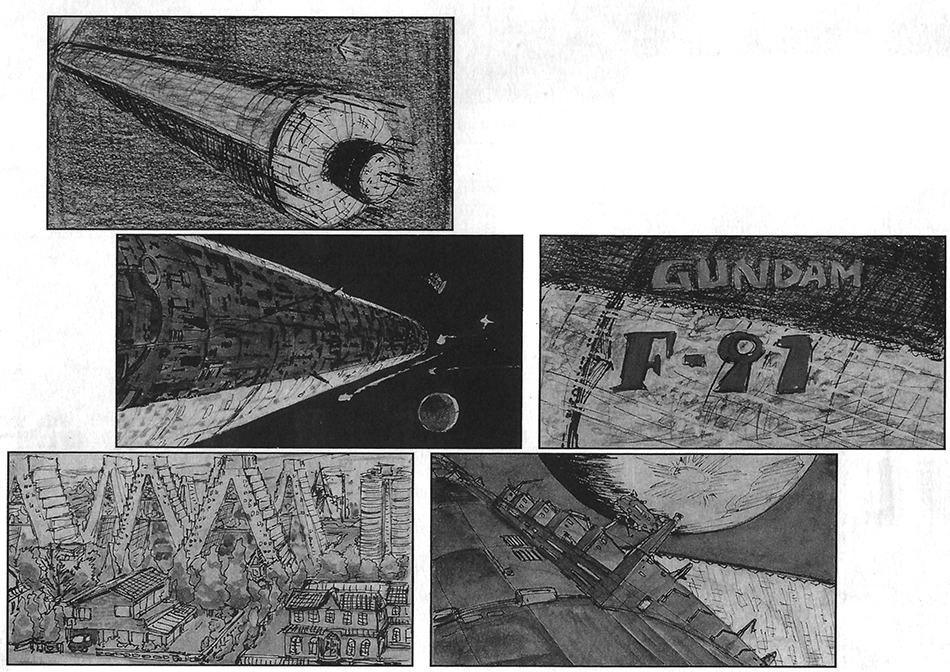
These are storyboards for the film created for the first phase at the end of March 1990. They were redrawn several times following this. I’ve included ones that typically are not seen in the colored reproductions. Hopefully this will help you appreciate and understand the richness behind the world that Tomino was setting out to create.
THE PROTAGONIST AND THE FILM
Tomino says that F91 has a happy ending, which is quite different from his previous works (and not what he was ultimately aiming for). Since this work is the jumping-off point, he didn’t know what the real ending would be, since he felt this would be the prologue for future works. Since there might be future stories of farewell or confrontation, he crafted it so that you could see one of the story’s main points at the moment, which is why we have a happy ending.
While he says that if he had tried to make a narrative about an upgraded robot, it wouldn’t have turned out like this, but that’s probably a good thing since this is considered the first work (first movie). But, he acknowledges that viewers/audience may feel that the film’s final battle is somewhat weak. In addition, there’s the frustration of not being able to squash the enemy completely. Typically, a movie should be completed in one sitting.
While this is the first step in the series, he tried to make it a complete movie wherever he could. But, he said he understood that the film would not be finished unless it was made in several parts. He says he feels sorry for the audience and that he’d be happy if people took this as the first film in the saga. But, he had some more tricks up his sleeve.
If they were going to make a new series, he wanted to ask both Okawara and Yasuhiko to do it if they could. They didn’t want to go back to the beginning because this was the first installment. Since it was something entirely new, he felt it’d be great if they could work on it with him since the “humanity of their characters has been completely lost in today’s animation.” The result, he says, was a resounding success.
ABOUT THE DESIGNS, ETC.
Tomino admits that he didn’t start out with a clear design idea for the Gundam or the main characters. He says that he isn’t very good with mecha or robots, and yet he felt that the Gundams up until that point had been overdone in many ways. He may have had a rough idea of what he was looking for, but that was only a minor detail.
When it came to the mecha, Okawara did a great job of putting it all together. He was able to make the F91 appear with a great form in the movie. Tomino came up with the rough idea for the Rafflesia, believing that it would be good to have mecha with such a distinct personality in the world of animation, so he figured he’d try his hand at creating something absurd. He laughs that he “abused his authority,” so to speak.
He goes on to say that the strange images he has for mecha aren’t always conveyed well to Okawara. For example, he drew a rough sketch of the space fortress A Baoa Qu, yet it wouldn’t turn out as something he liked if he asked for something like that from scratch. He says that everyone works too seriously on one thing at a time, so he sometimes asks them to work on something he drew as well (and wonders whether that’s really something he should do or not).
He admits that, in truth, it’s scary that something you put on TV with such simple intentions morphs into a product. Likewise, it’s scary when a product ends up taking on a life of its own. But, on the other hand, he’s grateful that things have come so far. Typically, works aren’t produced to this extent. He says that he’s always created his works without regard for commercialization and that F91 was no exception at the time.
He says that if Okawara is aware of commercialization, his colors come out rather boldly. But, in this instance, he didn’t do that at all. He says that he often liked many of the initial rough designs that Okawara submitted to him, but when he asked him to make specific changes, some of the good parts disappeared. He pondered to himself why this happened and surmised that perhaps he put too much thought into commercialization, thus resulting in rigid designs. He goes on to say that because the two have different roles and positions, their design theories and concepts differ. But, they were able to create a new form for the mobile suit.
ABOUT NEW WEAPONS
As he mentioned earlier, he’s not good at mecha, and even though he considered meddling with the F91 or the bio-computer, he left all the design work to the staff. So, his next frustration was with new weapons. He says he asked the staff to develop new weaponry, but they failed to, so he often ended up doing it himself (which he felt was not a good idea). So, while he’s pondering whether the weapon is really the right one or not, it ends up in the film. So, once it’s in film, it becomes fact.
He first thought that beam shields were a great idea at first, but as he was working on the production, he noticed a pretty big flaw, which he was currently struggling to deal with. He first thought that the beam shields would reduce the amount of work required, but as he’s doing the storyboarding, he could only get the MS to pose in a way that would hide the flaws. It was still much easier to use a conventional fixed shield, which he was shocked. But, he really liked it as a drawing. So that’s a drawback of the beam shield. He says he could tell you one thing, though: beams of light are pretty noticeable, making you a target in the darkness of space. As for the remainder of the drawbacks, well, he laughs and says to watch the movie and think about them for yourself.
He says he plans to use the beam shields in the future, as they make for good art, and he’s come up with a way to deal with its flaws. In the movie, he hasn’t been able to implement the use of beam shields fully. He says he considered using a white glass image, but that didn’t work either. He says that it’s not as easy as it sounds, creating a light wave that can be used as a defensive shield. So, there you have the difficulties behind crafting new weapons. He says this is definitely an area that he feels they need to improve in the future. So, they’ll have to keep working on weaponry in the future (aka a lot of ingenuity).
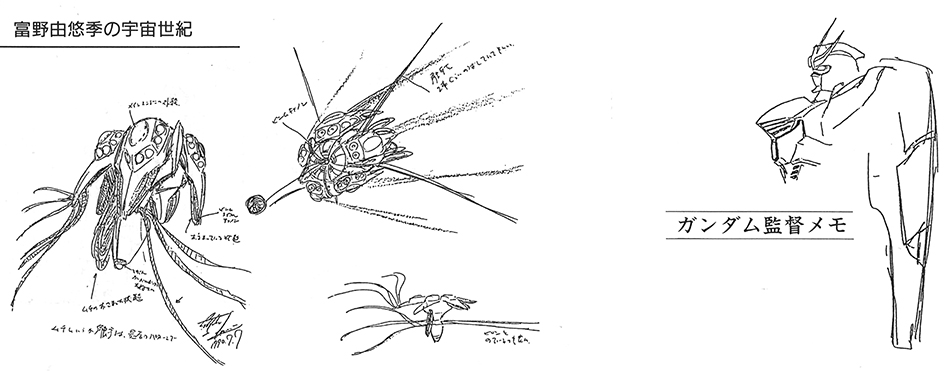
(Right) Design changes proposed by Tomino to Okawara about the F91’s rough draft. The line from the VSBR to the chest was ordered. (Left) As mentioned in the discussion, this is Tomino’s idea for the Rafflesia mobile armor. An organic mecha that has never been seen before in the series.
STORYBOARD, PICTURE, AND PRODUCTION
This was the first time he drew a storyboard.
He hadn’t drawn storyboards in almost three years, so he wanted to practice it. Another reason was that he wanted to prevent himself from forgetting about the story when he got caught up in the scenario. He also cautions that he’d like to work on the storyboard from now on, barring any TV shows. He feels that most of the scenes he drew are reproduced in a way that’s easy to see in the film, so he’s quite grateful for the film and background artists for their hard work. He says that the backgrounds, in particular, are very solid and provide a good foothold for the screen.
He goes on to say that he didn’t really care much for the colors, which is rather problematic. He says that there are certain colors that Sunrise has, which is a physical problem. He says that there’s still a lack of sense of color among the staff and himself, which he thinks won’t be solved unless he does two or three more films. In terms of production, however, he didn’t make any changes, just good old-fashioned production.
THE RONAH FAMILY AND BABYLONIA
When he finished the storyboards, he felt that the Rona family was like the Zabi family, but he didn’t notice it when he first drew them. His reason behind this is that he started with the film’s central theme and created the relationships between the characters that tell the story. Meanwhile, the Zabi family started from their looks, so there is a surprising difference in methodology. So, he feels that the film’s theme was definitely the right one, and he hopes the audience picked up on that.
He created “Iron Mask” as a character that wasn’t found in the current Gundam world, so “Iron Mask” was something entirely new. Yasuhiko was also quite surprised, saying, “That Iron Mask?” He thought it would be challenging to create such a character since they were starting from the theme alone, but considering the relative ease of understanding the film, they needed a character that wouldn’t fit into a work that was half make-believe and half robot. Yaz reluctantly drew it, and when he looked at the character sheet, he realized that there was Char in Gundam. He laughs but stresses that Iron Mask is a truly new and important character and has a powerful presence.
He says that the imagery of the Crossbone, the Denan-type MS, in particular, were taken from Babylonian reliefs. Tomino stresses that he had a hard time finding them in the beginning, but he has a lot of respect for Okawara, who succeeded in creating a mobile suit from those pictures. As for the names, he says they’re also taken from Babylonia. The name’s pronunciation was chosen from the genealogy of the royal family and was made close to match the Japanese katakana. He says you can’t just pull that name from your imagination. Once they had a relatively secure footing in Babylonia, work progressed rather quickly, but it was a struggle to get there.
SEABOOK AND CECILY ARE GOOD KIDS THIS TIME
Tomino says that the main character is an easy-to-understand protagonist who acted with the ethics of his generation, but he’s worried about how today’s kids would accept it. He says that it’s completely different from Char’s Counterattack. He finishes by saying that while it’s not finished yet, he’s confident that F91 would be a new jumping-off point for him as well.



